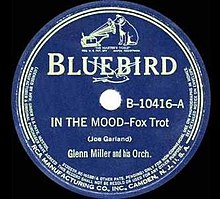
Back In the Mood Catalan In the Mood German In the Mood Esperanto In the Mood Spanish In the Mood French In the Mood HE In the Mood Hungarian In the Mood Italian イン・ザ・ムード Japanese In the Mood Dutch
| "In the Mood" | |
|---|---|
 | |
| Single by Glenn Miller and His Orchestra | |
| B-side | "I Want to Be Happy" |
| Published | November 27, 1939 Shapiro, Bernstein & Co., Inc., New York[1] |
| Released | September 15, 1939 |
| Recorded | August 1, 1939 |
| Studio | RCA Victor, New York City |
| Genre | Big band, swing |
| Length | 3:40 |
| Label | Bluebird (US) His Master's Voice (UK) |
| Songwriter(s) | Wingy Manone (c), Andy Razaf (w), Joe Garland (a) |
| "In the Mood" | ||||
|---|---|---|---|---|
 | ||||
| Single by Ernie Fields | ||||
| B-side | "Christopher Columbus" | |||
| Released | June 1959 | |||
| Genre | Jazz, instrumental | |||
| Length | 2:29 | |||
| Label | Rendezvous | |||
| Songwriter(s) | Wingy Manone (c), Andy Razaf (w), Joe Garland (a) | |||
| Ernie Fields singles chronology | ||||
| ||||
"In the Mood" is a popular big band-era jazz standard recorded by American bandleader Glenn Miller. "In the Mood" is based on the composition "Tar Paper Stomp" by Wingy Manone. The first recording under the name "In the Mood" was released by Edgar Hayes & His Orchestra in 1938.
In 1983, the Glenn Miller recording from 1939 was inducted into the Grammy Hall of Fame. In 2004, the recording was inducted into the Library of Congress National Recording Registry which consists of recordings that are "culturally, historically, or aesthetically significant."
In 1999, National Public Radio (NPR) included the 1939 Glenn Miller recording in its list of "The 100 most important American musical works of the 20th century".[2][3]
Glenn Miller's "In the Mood", with "I Want to Be Happy" on the B-side, became the best-selling swing instrumental.[4][5]
- ^ Library of Congress. Copyright Office. (1940). Catalog of Copyright Entries 1940 Musical Compositions New Series Vol 35 Pt 3 For the Year 1940. United States Copyright Office. U.S. Govt. Print. Off.
- ^ "NPR 100". www.npr.org. Retrieved November 10, 2018.
- ^ NPR 100. The 100 most important American musical works of the 20th century.
- ^ Cite error: The named reference
pc2awas invoked but never defined (see the help page). - ^ Gioia, Ted (2012). The Jazz Standards: A Guide to the Repertoire. New York City: Oxford University Press. pp. 185–186. ISBN 978-0-19-993739-4.